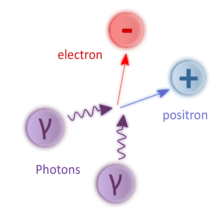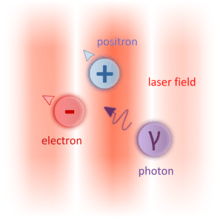Breit–Wheeler process
The Breit–Wheeler process or Breit–Wheeler pair production is a physical process in which a positron–electron pair is created from the collision of two photons. It is the simplest mechanism by which pure light can be potentially transformed into matter. The process can take the form γ γ′ → e+ e− where γ and γ′ are two light quanta.[1]


The multiphoton Breit–Wheeler process, also referred to as nonlinear Breit–Wheeler or strong field Breit–Wheeler in the literature, is the extension of the pure photon–photon Breit–Wheeler process when a high-energy probe photon decays into pairs propagating through an electromagnetic field (for example, a laser pulse).[2] In contrast with the previous process, this one can take the form of γ + n ω → e+ e−, where ω represents the coherent photons of the laser field.
The inverse process, e+ e− → γ γ′, in which an electron and a positron collide and annihilate to generate a pair of gamma photons, is known as electron–positron annihilation or the Dirac process[3] for the name of the physicist who first described it theoretically and anticipated the Breit–Wheeler process.
This mechanism is theoretically characterized by a very weak probability, so producing a significant number of pairs requires two extremely bright, collimated sources of photons having photon energy close or above the electron and positron rest mass energy. Manufacturing such a source, a gamma-ray laser, is still a technological challenge. In many experimental configurations, pure Breit–Wheeler is dominated by other more efficient pair creation processes that screen pairs produced via this mechanism.[2][4][5] The Dirac process (pair annihilation) has nonetheless been by far verified experimentally. This is also the case for the multiphoton Breit–Wheeler, which was observed at the Stanford Linear Accelerator Center in 1997 by colliding a high-energy electrons with a counter-propagating terawatt laser pulse.[6][7]
Although this mechanism is still one of the most difficult to be observed experimentally on Earth, it is of considerable importance for the absorption of high-energy photons travelling cosmic distances.[8][9][5]
The photon–photon and the multiphoton Breit–Wheeler processes are described theoretically by the theory of quantum electrodynamics.
History
The photon–photon Breit–Wheeler process was described theoretically by Gregory Breit and John A. Wheeler in 1934 in Physical Review.[1] It followed previous theoretical work of Paul Dirac[3] on antimatter and pair annihilation. In 1928, Paul Dirac's work proposed that electrons could have positive and negative energy states following the framework of relativistic quantum theory but did not explicitly predict the existence of a new particle.
Experimental observations
Photon–photon Breit–Wheeler possible experimental configurations
Although the process is one of the manifestations of the mass–energy equivalence, as of 2017, the pure Breit–Wheeler has never been observed in practice because of the difficulty in preparing colliding gamma ray beams and the very weak probability of this mechanism. Recently, different teams have proposed novel theoretical studies on possible experimental configurations to finally observe it on Earth.
In 2014, physicists at Imperial College London proposed a relatively simple way to physically demonstrate the Breit–Wheeler process.[10] The collider experiment that the physicists proposed involves two key steps. First, they would use an extremely powerful high-intensity laser to accelerate electrons to nearly the speed of light. They would then fire these electrons into a slab of gold to create a beam of photons a billion times more energetic than those of visible light. The next stage of the experiment involves a tiny gold can called a hohlraum (German for 'empty room'). Scientists would fire a high-energy laser at the inner surface of this hohlraum to create a thermal radiation field. They would then direct the photon beam from the first stage of the experiment through the centre of the hohlraum, causing the photons from the two sources to collide and form electrons and positrons. It would then be possible to detect the formation of the electrons and positrons when they exited the can.[10] Monte Carlo simulations suggest that this technique is capable of producing of the order of 105 Breit–Wheeler pairs in a single shot.[11][12]
In 2016, a second novel experimental setup has been proposed and studied theoretically in [4] to demonstrate and study the Breit–Wheeler process. They propose to collide two high-energy photon sources (composed of non-coherent hard x-ray and gamma-ray photons) generated from the interaction of two extremely-intense lasers on solid thin foils or gas jets. With the forthcoming generations of short-pulse extremely intense lasers, laser interaction with solid target will be the place of strong radiative effects driven by the nonlinear inverse quantum scattering. This effect, negligible so far, will become a dominant cooling mechanism for the extremely relativistic electrons accelerated above the 100-MeV level at the laser-solid interface via different mechanisms.
Multiphoton Breit–Wheeler experiments
The multiphoton Breit–Wheeler has already been observed and studied experimentally. One of the most efficient configuration to maximize the multiphoton Breit–Wheeler pair production consists on colliding head-on a bunch of gamma photon with a counter-propagating (or with a slight collision angle, the co-propagating configuration being the less efficient configuration) ultra-high intensity laser pulse. To first create the photons and then have the pair production in an all-in-one setup, the similar configuration can be used by colliding giga-electronvolt (GeV) electrons. Depending on the laser intensity, these electrons will first radiate gamma photons via the so-called nonlinear inverse Compton scattering mechanism when interacting with the laser pulse. Still interacting with the laser, the photons then turn into multiphoton Breit–Wheeler electron-positron pairs.
This method has been considered In 1997 at the Stanford Linear Accelerator Center. Researchers were able to conduct the multiphoton Breit–Wheeler process using electrons to first create high-energy photons,[13] which then underwent multiple collisions to produce electrons and positrons, all within same chamber.[6][7][14] Electrons were accelerated in the linear accelerator to an energy of 46.6 GeV before being sent head-on to a Neodymium (Nd:glass) lineary polarized laser of intensity 1018 W/cm2 (maximal electric field amplitude of around 6×109 V/m), of wavelength 527 nanometers and duration 1.6 picoseconds. In this configurations, it has been estimated that photons of energy up to 29 GeV were generated. This led to the yield of 106 ±14 positrons with a broad energy spectrum in the GeV level (peak around 13 GeV).
The latter experiment may be reproduced in the future at SLAC with more powerful present laser technologies. The use of higher laser intensities (1020 W/cm2 is now easily achievable with turnkey short-pulse titanium-sapphire laser solutions) would significantly enhance process efficiencies (inverse nonlinear Compton and nonlinear Breit–Wheeler pair creation) leading to higher antimatter production at several orders of magnitude. It could enable to perform high-resolution measurements as well as to characterize additional mass-shift, nonlinear and spin effects.[15]
The extreme intensities expected to be available on the upcoming multi-petawatt laser systems will allow all-optical, laser-electron collision schemes. In an all-optical configuration, the electron beam is generated from the laser interaction with a gas jet in the so-called laser wakefield acceleration regime. The electron bunch is made to interact with a second high-power laser in order to study QED processes. The feasibility of an all-optical multiphoton Breit–Wheeler pair production scheme has been first demonstrated theoretically in.[16] This scheme is therefore restricted to multi-beam short-pulse extreme-intensity laser facilities, as will be the case of the CILEX-Apollon[17] and ELI systems[18] (CPA titanium sapphire technology at 0.8 micrometer, duration of 15-30 femtoseconds). The generation of electron beams of few GeV and few nano-Coulomb is possible with a first laser of 1 petawatt combined with the use of tuned and optimized gas-jet density profiles such as two-step profiles. Strong pair generation can be achieved by colliding head-on this electron beam with a second laser of intensity above 1022 W/cm2. In this configuration at this level of intensity, theoretical studies predict that several hundreds of pico-Coulombs of antimatter could be produced.[19] This experimental setup could even be one of the most prolific positron yield factory. This all-optical scenario may be preliminary tested with lower laser intensities of the order of 1021 W/cm2.
References
- G. Breit and John A. Wheeler (15 December 1934). "Collision of Two Light Quanta". Physical Review. 46 (12): 1087–1091. Bibcode:1934PhRv...46.1087B. doi:10.1103/PhysRev.46.1087.CS1 maint: uses authors parameter (link)
- A. I. Titov, B. Kämpfer, H. Takabe, and A. Hosaka (10 April 2013). "Breit–Wheeler process in very short electromagnetic pulses". Physical Review. 87 (4): 042106. arXiv:1303.6487. Bibcode:2013PhRvA..87d2106T. doi:10.1103/PhysRevA.87.042106.CS1 maint: uses authors parameter (link)
- Dirac, P. a. M. (July 1930). "On the Annihilation of Electrons and Protons". Mathematical Proceedings of the Cambridge Philosophical Society. 26 (3): 361–375. Bibcode:1930PCPS...26..361D. doi:10.1017/S0305004100016091. ISSN 1469-8064.
- Ribeyre, X.; d'Humières, E.; Jansen, O.; Jequier, S.; Tikhonchuk, V. T.; Lobet, M. (2016). "Pair creation in collision ofγ-ray beams produced with high-intensity lasers". Physical Review E. 93 (1): 013201. arXiv:1504.07868. Bibcode:2016PhRvE..93a3201R. doi:10.1103/PhysRevE.93.013201. ISSN 2470-0045. PMID 26871177.
Direct production of electron-positron pairs in two-photon collisions, the Breit–Wheeler process, is one of the basic processes in the universe. However, it has never been directly observed in the laboratory because of the absence of the intense γ-ray sources
- Ruffini, Remo; Vereshchagin, Gregory; Xue, She-Sheng (2010-02-01). "Electron–positron pairs in physics and astrophysics: From heavy nuclei to black holes". Physics Reports. 487 (1): 1–140. arXiv:0910.0974. Bibcode:2010PhR...487....1R. doi:10.1016/j.physrep.2009.10.004.
- Bamber, C.; Boege, S. J.; Koffas, T.; Kotseroglou, T.; Melissinos, A. C.; Meyerhofer, D. D.; Reis, D. A.; Ragg, W.; Bula, C. (1999-11-01). "Studies of nonlinear QED in collisions of 46.6 GeV electrons with intense laser pulses". Physical Review D. 60 (9): 092004. Bibcode:1999PhRvD..60i2004B. doi:10.1103/PhysRevD.60.092004. ISSN 1550-7998.
- Bamber, C.; Berridge, S. C.; Boege, S. J.; Bugg, W. M.; Bula, C.; Burke, D. L.; Field, R. C.; Horton-Smith, G.; Koffas, T. (1997-02-25). "Positron production in multiphoton light-by-light scattering". AIP Conference Proceedings. 396 (1): 165–177. Bibcode:1997AIPC..396..165B. CiteSeerX 10.1.1.388.7683. doi:10.1063/1.52962. ISSN 0094-243X.
- Nikishov, A. I. (1961-08-01). "Absorption of High Energy Photons in the Universe". Zhurnal Eksperimental'noi i Teoreticheskoi Fiziki (in Russian). 41. OSTI 4836265.
- Gould, Robert J.; Schréder, Gérard P. (1967-03-25). "Pair Production in Photon-Photon Collisions". Physical Review. 155 (5): 1404–1407. Bibcode:1967PhRv..155.1404G. doi:10.1103/PhysRev.155.1404.
- "Scientists discover how to turn light into matter after 80-year quest". Phys.org. 18 May 2014. Retrieved 24 July 2015.
- O. J. Pike, F. Mackenroth, E. G. Hill and S. J. Rose (18 May 2014). "A photon–photon collider in a vacuum hohlraum". Nature Photonics. 8 (6): 434–436. Bibcode:2014NaPho...8..434P. doi:10.1038/nphoton.2014.95.CS1 maint: uses authors parameter (link)
- Thomas, Alexander (June 2014). "Optical physics: Antimatter creation in an X-ray bath". Nature Photonics. 8 (6): 429–431. Bibcode:2014NaPho...8..429T. doi:10.1038/nphoton.2014.118. ISSN 1749-4885.
- Bula, C.; McDonald, K. T.; Prebys, E. J.; Bamber, C.; Boege, S.; Kotseroglou, T.; Melissinos, A. C.; Meyerhofer, D. D.; Ragg, W. (1996-04-22). "Observation of Nonlinear Effects in Compton Scattering". Physical Review Letters. 76 (17): 3116–3119. Bibcode:1996PhRvL..76.3116B. doi:10.1103/PhysRevLett.76.3116. PMID 10060879. Archived from the original on 2019-06-21. Retrieved 2019-06-21.
- Akshat Rathi (19 May 2014). ""Supernova in a bottle" could help create matter from light". Ars Technica. Retrieved 20 May 2014.
- Hartin, A.; Porto, S.; Moortgat-Pick, G. (2014-04-03). "Testing nonlinear-QED at the future linear collider with an intense laser". arXiv:1404.0810 [hep-ph].
- Sokolov, Igor V.; Naumova, Natalia M.; Nees, John A.; Mourou, Gérard A. (2010-11-04). "Pair Creation in QED-Strong Pulsed Laser Fields Interacting with Electron Beams". Physical Review Letters. 105 (19): 195005. arXiv:1009.0703. Bibcode:2010PhRvL.105s5005S. doi:10.1103/PhysRevLett.105.195005. PMID 21231176.
- Cros, B.; Paradkar, B. S.; Davoine, X.; Chancé, A.; Desforges, F. G.; Dobosz-Dufrénoy, S.; Delerue, N.; Ju, J.; Audet, T. L. (2014-03-11). "Laser plasma acceleration of electrons with multi-PW laser beams in the frame of CILEX". Nuclear Instruments and Methods in Physics Research Section A: Accelerators, Spectrometers, Detectors and Associated Equipment. Proceedings of the first European Advanced Accelerator Concepts Workshop 2013. 740: 27–33. Bibcode:2014NIMPA.740...27C. doi:10.1016/j.nima.2013.10.090.
- Mourou, Gérard; Tajima, Toshiki (2011-07-01). "The Extreme Light Infrastructure: Optics' Next Horizon". Optics and Photonics News. 22 (7): 47–51. doi:10.1364/OPN.22.7.000047. ISSN 1541-3721.
- Lobet, M.; Davoine, X.; d’Humières, E.; Gremillet, L. (2017). "Generation of high-energy electron-positron pairs in the collision of a laser-accelerated electron beam with a multipetawatt laser". Physical Review Special Topics: Accelerators and Beams. 20 (4): 043401. Bibcode:2017PhRvS..20d3401L. doi:10.1103/physrevaccelbeams.20.043401.